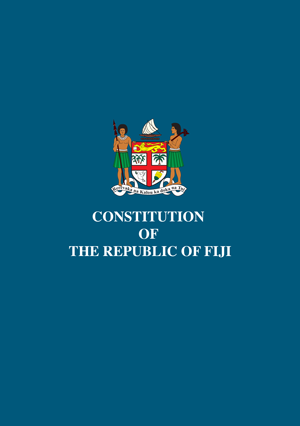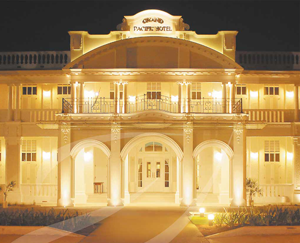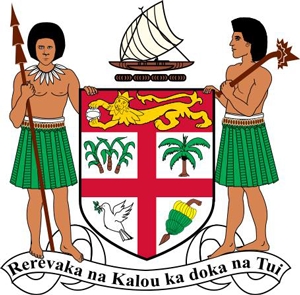 The final version of the 2013 Constitution that will underpin the first genuine democracy in Fijian history has been released to the public. His Excellency the President, Ratu Epeli Nailatikau, gave his assent to the document on 6th September, 2013. It is the supreme law of the country and paves the way for elections by September 30th, 2014 conducted, for the first time, on the basis of equal votes of equal value. It is in line with the constitutions of some of the world’s most liberal democracies and provides a framework for the development of a modern, progressive state. The 98-page constitutional document in English has also, for the first time, been translated into the two main vernacular languages – i’Taukei and contemporary Hindi.
The final version of the 2013 Constitution that will underpin the first genuine democracy in Fijian history has been released to the public. His Excellency the President, Ratu Epeli Nailatikau, gave his assent to the document on 6th September, 2013. It is the supreme law of the country and paves the way for elections by September 30th, 2014 conducted, for the first time, on the basis of equal votes of equal value. It is in line with the constitutions of some of the world’s most liberal democracies and provides a framework for the development of a modern, progressive state. The 98-page constitutional document in English has also, for the first time, been translated into the two main vernacular languages – i’Taukei and contemporary Hindi.
Reminiscing we have come a long way
The history and the good old days back in the Fiji Islands – By Neil Billings
GPH 100th Anniversary
 Grand Pacific Hotel (GPH as it’s known world wide) celebrated it’s 100th Anniversary on May 23, 2014. The original construction of the Grand Pacific Hotel began in 1909 and was completed five years later, with its opening on May 23, 1914. Papua New Guinea’s National Superannuation Fund (NASFUND) owns 50 per cent shares in the Grand Pacific Hotel while the Fiji National Provident Fund (FNPF) and Papua New Guinea’s Lamana Development both own 25 per cent shares. It has recently been rebuilt and refurbished. The iconic hotel along Victoria Parade in Suva has reopened its doors to Fijians and international visitors as probably one of the best in the Pacific.
Grand Pacific Hotel (GPH as it’s known world wide) celebrated it’s 100th Anniversary on May 23, 2014. The original construction of the Grand Pacific Hotel began in 1909 and was completed five years later, with its opening on May 23, 1914. Papua New Guinea’s National Superannuation Fund (NASFUND) owns 50 per cent shares in the Grand Pacific Hotel while the Fiji National Provident Fund (FNPF) and Papua New Guinea’s Lamana Development both own 25 per cent shares. It has recently been rebuilt and refurbished. The iconic hotel along Victoria Parade in Suva has reopened its doors to Fijians and international visitors as probably one of the best in the Pacific.
Brief Fiji History Timeline

Brief Fiji history timeline from 1643…
1643 – Dutch explorer Abel Tasman is the first European to visit the Fiji islands.
1774 – Landing of Captain Cook on Vatoa island.
1789 – Journey of Captain Bligh through Fiji group after mutiny on Bounty
1791 – Rotuma discovered by Capt. Edwards.
Late 1790s – Arrival of Jacko – a monkey, and a cat, at Bau, from a ship searching for sandalwood.
1800 – Wreck of schooner Argo in Lau group.
1801 – Discovery of sandalwood at Vanua Levu by El Plumier; beginning of sandalwood trade; several European seamen and convicts living with Fijian chiefs; introduction of muskets.
1812 – Killing of crew of Hunter by men of Wailia.
1822 – Arrival of David Whippy of New Hampshire, USA.
1826 – Arrival of first Christian (LMS) missionaries, from Tahiti, at Lakeba, then Oneata; arrival of J H Danford (Harry the Jew).
1835 – Arrival of first European missionaries (William Cross & David Cargill) (Methodist) at Lakeba; internal warfare between tribes.
1838 – Arrival of more Christian missionaries (J Hunt, T Calvert, T Jaggar) (Methodist).
1839 – First book printed in Fijian (Catechism) produced.
1840 – Visit of United States Exploring Expedition. First mapping of Fiji Islands. Levuka was principal settlement of Europeans.
1840 – Appointment of JB Williams of Salem, Massachusetts, previously US Consul in NZ, as US Commercial agent for Fiji, on Nukulau Island.
1840 – Christian missionaries arrive on Rotuma.
1840s-50s – Christian convert Chief Ratu Seru Epenisa Cakobau gains control of most of Western Fiji. Cakobau was a Fijian chief and warlord from the island of Bau, off the eastern coast of Viti Levu, who united part of Fiji’s warring tribes under his leadership. He then styled himself as Tui Viti or King of Fiji, and then Vunivalu, or Protector, after the cession of Fiji to the United Kingdom in 1874.
1844 – Europeans banished to Solevu Bay, Vanua Levu by Cakobau.
1848 – Henele Ma’afu , cousin o the King of Tonga, arrives in Lakeba, Lau.
1849 – Burning down of JB Williams’ house on Nukulau. Property looted by Fijians. Williams (US Govt) sued Cakobau for damages.
1850s – Visits of Mary Wallis (A Lady).
1852 – Arrival of S A St John.
1854 – Ma’afu given sovereignty over Lomaloma by Tui Cakau, gradually extends power over whole Lau group in Eastern Fiji.
1855-56 – Survey of Fijian waters by HM survey ship Herald.
1856 – Exploration of Rewa River valley by Dr MacDonald of HMS Herald; visit of French warship Bonze to Levuka; arrival of RS Swanston. Methodist schools established at Davuilevu.
1858 – Arrival of WT Pritchard – first British Consul – at Levuka; arrival of USS Vandalia to discuss US claim for payment with Cakobau. Pritchard takes Cakobau’s offer of Fiji to Britain if Britain would repay US debt. Offer not accepted. Swanston acting British Consul. Marist Brothers arrive in Levuka.
1859 – Ma’afu renounces any claim to Fiji by Tonga; Dr B Seeman arrived to spend one year studying botany of Fiji.
1860 – Arrival of W T Smythe to investigate possibility of cession and prospects of cotton growing; death of JB Williams; influx of settlers from Australia and NZ; Dr I M Brower 2nd US Consul.
1861 – Smythe’s report advised against annexing Fiji; claim made by Ma’afu, on behalf of King George of Tonga, against Cakobau for damages made during Kaba campaign
1862 – Tui Cakau captured by Tongans; battle of Wairiki; Wainikolo (Tongan chief) killed.
1863 – Pritchard removed from office as British Consul, by commissioners from NSW acting on behalf of Foreign Office.
1864 – First labourers from New Hebrides arrive in Fiji. Beginning of Labour trade.
1865 – Formation of Confederacy of Independent Chiefs of Fiji (Tovata 1).
1866 – White population of Fiji approximately 500; cotton boom, due to neglect of American cotton plantations during American Civil War, but 2 large hurricanes which destroyed plantations, and the Siege of Paris destroying French cotton mills, caused gradual collapse of cotton industry. Swanston joins Ma’afu as secretary. S A St John was Cakobau’s secretary.
1867 – Formation of Confederation of North and East Fiji (Lau Confederacy) led by Tui Cakau . JB Thurston Acting British Consul. Many foreign settlers in Lau group. SA St John frames a Constitution for Cakobau, based on that of Hawaii. Cakobau crowned King of Bau. US Tuscarora arrives to enforce settlement of Cakobau’s debt to USA. T Baker – Wesleyan missionary – killed by Vatusila villagers up the Sigatoka river. Foreign population approximately 831.
1868 – Cakobau’s forces march on hill people to revenge Baker’s death. Gold discovered in Navua River. Thurston replaced by March as British Consul.
1869 – Setting up of Polynesian Company, which bought land in Beqa, Rewa, Viti Levu, and Suva. Founding of Fiji Times newspaper. Chiefdom of Lau set up, under Ma’afu. Meeting of Cakobau and Ma’afu to discuss possible ceding of Fiji to America or some other government.
1870 – Pritchard conducts investigations into land sales. Foreign population over 2000.
1870s – Trans-Pacific steamships using port of Kadavu.
1871 – Bishop Patteson killed in New Hebrides, partly as result of labour trade. Electoral roll of Levuka appeared in Fiji Times. European settlers at Levuka organize a national government and name Cakobau King of Fiji following local disorder. Ma’afu Governor of Lau. Lovoni people conquered by Cakobau’s forces, sold to planters as labourers. Spiers and McIntosh killed at Ba. Cakobau mounted an expedition of revenge. Legislative Assembly and Armed Constabulary set up. Rev W. Floyd (Anglican) arrived in Levuka.
1872 – Polynesian Islanders Protection Act passed in London. Poll tax of all men in Fiji. British Subjects’ Mutual Protection Society and Volunteer Corps set up in Levuka against Cakobau, supported by March. Thurston took on position of Acting Premier, in place of Woods, who was in Australia seeking recognition o Cakobau’s government. Cotton trade collapsed. Start of sugar cane plantations. Opening of Masonic Lodge Polynesia in Levuka.
1873 – First successful exports of sugar from Fiji sent to London.
1874 – Fiji’s Cession by the chiefs to Queen Victoria (Alexandrina Victoria- 24 May 1819- 22 January 1901) in a ceremony at Levuka, the old capital, on 10 October 1874; Fiji becomes a British crown colony at the request of Cakobau and other chiefs to Sir Hercules Robinson, Governor of NSW. British rule. First Governor- Sir Arthur Hamilton Gordon. Fiji Land Commission set up.
1875 – British Royal Engineers build Levuka sea-wall.
1875-76 – Measles epidemic wipes out one-third of the Fijian population; British forces and Fijian chiefs suppress rebellion.
1877– Municipality of Levuka established; High Commission for Western Pacific set up, based in Suva. Governor of Fiji was also British High Commissioner for Western Pacific.
1878 – Penang Sugar Mill built by Penang Sugar Estate.
1879 – Arrival of Leonidas with first indentured Indian labourers. Founding of Levuka Public School.
1880 – Colonial Sugar Refinery began operations in Fiji, took over many unprofitable sugarcane plantations in Rewa valley, built Nausori Mill.
1881 – Death of Ma’afu; Rotuma annexed by Britain.
1882 – Ratu Cakobau, the Vunivalu, died. Municipality of Suva established. Colonial Sugar Refinery’s Nausori Mill began crushing sugar. Founding of Marist Convent School, Levuka.
1883 – Burns Philp Company founded; Union Steamship Company started a steamship route – Melbourne -Fiji ; Founding of Suva Public School
1885 – A group of Fijian men were trained as native medical practitioners – beginning of medical training in Fiji. First Roman Catholic baptism in Fiji.
1887 – Simeon Lazarus elected Warden of Suva.
1888 – Birth of Ratu Sir Lala Sukuna, the second Tui Lau.
1891 – Agricultural and Industrial Exhibition held in Suva.
1893 – Canadian-Australian Steam Ship Company operated a service between Sydney, Suva, Honolulu, Victoria, British Columbia (BC) and Vancouver, BC.
1895 – CSR built Labasa Mill.
1897 – This became the Canadian-Australian Royal Mail Steam Ship Company running from Sydney, Wellington, Suva, Honolulu, Victoria BC, Vancouver.
1898 – Ratu Alifereti Finau, grandfather of Ratu Mara, made Sau ni Vanua and Tui Nayau; The Sydney-Vancouver route was taken over by the New Zealand Shipping Company.
1900 – The Union Steamship Company took over the route; Sydney, Auckland, Suva, Honolulu, Victoria, Vancouver.
1901 – Fiji Armed Constabulary send detachment to opening of Australian Commonwealth Parliament.
1902 – Pacific underwater cable network between Canada, Fanning Island, Fiji, NZ, Australia laid.
1904 – Legislative Council, consisting of elected Europeans and nominated Fijians, set up to advise the British governor. Sir Everard Im Thurn became Governor.
1906 – Queen Victoria School founded. Building of Vancouver – Fiji Sugar Company’s mill at Navua. Fire walkers of Beqa visit Christchurch Exhibition, NZ.
1907 – Native Fijian cricket team visits Melbourne.
1913 – Visit by poet Rupert Brooke.
1915 – Departure of Fiji Contingent to WWI.
1916 – British colonial government in India stops the recruitment of indentured labourers. More than 60,000 indentured labourers brought in from the Indian subcontinent to work on sugar plantations. Dept of Education set up.
1917 – Departure of Fiji Labour Corps to WWI; founding of Suva Boys’ Grammar School and Suva Girls’ Grammar School.
1918 – Tailevu Dairy Resettlement scheme set up.
1920 – Birth of Ratu Sir Kamisese Kapaiwai Tuimacilai Mara on 13 May; All labour indenture agreements in Fiji end.
1924 – NZ Teachers started to be sent to Fiji.
1928 – Central Medical School, Suva founded. First trans- Pacific flight by Kingsford-Smith and Ulm, via Fiji.
1932 – Cakobau’s war club, presented to Sir Hercules Robinson – first Governor of Fiji, returned to Fiji to become mace of Fiji Legislative Council
1934 – Gold rush, due to opening of Tavua goldfield.
1935 – Centenary of Christianity in Fiji.
1941 – NZ assumes responsibility for defence of Fiji. American troops based in Fiji. Fijian troops serve in Solomon Islands.
1947 – First Fijian dentist graduated.
1948 – India sends Commissioner to Fiji.
1949 – 75 year anniversary of Cession
1952 – Arrival of Rhinoceros beetle pest in Fiji, severely damaging copra plantations. Fiji Troops serve in Malaya. Governorship of Fiji and High Commissioner of Western Pacific posts were separated. Western Pacific High Commission moved to Honiara, Solomon Islands
1953 – Visit by Queen Elizabeth II. She opened the Fiji Medical School at Tamavua.
1956 – Census reveals that Indians outnumber iTaukei.
1959 – Strikes and street riots in Suva.
1963 – Ratu Sir Kamisese Mara made the third Tui Lau, after Ma’afu and Ratu Sir Lala Sukuna; Women and Fijians enfranchised; predominantly Fijian Alliance Party set up. Pacific Games held in Fiji.
1965 – First London Constitutional Conference at Marlborough House.
1967-1970 – Chief Minister, Ratu Sir Kamisese Mara.
1968 – Founding of University of the South Pacific.
1969 – Ratu Sir Kamisese Mara installed as Tui Nayau and Sau ni Vanua, Lakemba
1970 – London Constitutional Conference at Marlborough House, April or May; Fiji becomes independent with Ratu Sir Kamisese Mara of the Alliance Party as Prime Minister – the date of independence to be 10 October 1970, the ninety-sixth anniversary of the signing of the Deed of Cession; Her Majesty Queen Elizabeth represented by His Royal Highness the Prince of Wales, Prince Charles; swearing in of Fiji’s first Governor-General, Sir Robert Foster; Fiji welcomed to the United Nations General Assembly.
1971 – Fiji is admitted to the Commonwealth at the Heads of Government meeting in Singapore; formation of The Pacific Forum.
1972 – First election held under the 1970 Constitution, won by the Alliance party with 33 seats out of 52; Fiji Sugar Corporation Limited formed, which took over CSR Company operations in 1973.
1973 – Ratu George Cakobau sworn in as first Fijian Governor-General on 13 June, great grandson of Ratu Cakobau, the man who ceded Fiji to Her Majesty the Queen of Fiji’s great-great-grandmother, Queen Victoria, nearly 100 years earlier.
1975 – CSR Company finally left Fiji.
1977 – Election won by the National Federation Party with 26 seats, Alliance 24, Fijian Nationalist Party 1, and Independent 1; when the NFP hesitated to take power the Governor-General appointed Sir Ratu Kamisese Mara of the Alliance Party to form a government.
1978 – Fiji provides a light infantry battalion of about 500 men (which later rose to 725) to the United Nations Interim Force in Lebanon (UNIFIL).
1981 – The South Pacific Regional Trade and Economics Agreement (SPARTECA) gave island countries duty-free and unrestricted access to Australia and New Zealand; visit by the Prime Minister of India Mrs Indira Gandhi.
1982 – Alliance Party wins election with 28 seats; Visit by Her Majesty Queen Elizabeth II; Fiji hosts first Commonwealth Heads of Government Regional Meeting.
1984 – Fijian Holdings Ltd formed as an investment company.
1985 – Timoci Bavadra sets up the Fiji Labour Party with trade union support.
1986 – A Fijian ceremonial welcome for His Holiness Pope John Paul II, November.
1987 – Indian-dominated coalition led by Bavadra wins general election, ending 17 years of rule by the AP and Prime Minister Mara; Taukei Movement became more outspoken and aggressive; first bloodless military coup d’état on 14 May, led by Lieutenant-Colonel Sitiveni Rabuka, the third down in the military hierarchy of the Fiji Military Forces, with the aim of making indigenous Fijians politically dominant; Rabuka stages a second coup on 28 September and appoints Governor-General Ratu Sir Penaia Ganilau president; Ganilau in turn appoints Ratu Mara prime minister; Rabuka declares Fiji a Republic 7 October; Fiji excluded from Commonwealth; Britain, the United States, Australia and New Zealand suspend aid.
1987-1992 – Interim government appointed December led by Prime Minister Ratu Sir Kamisese Mara.
1989 – Thousands of ethnic Indians flee Fiji.
1990 – New constitution enshrining political dominance for indigenous Fijians introduced.
1992 – Rabuka, of the Fijian Political Party (FPP), becomes prime minister following general election.
1993 – President Ratu Sir Penaia Ganilau died 15 December; President from 1987 to 1993.
1994 – Great Council of Chiefs appoints Ratu Sir Kamisese Mara President and Commander in Chief, Republic of Fiji in January following the death of Ganilau in the previous month; Rabuka and the FPP win general election.
1994 – Fiji re-admitted to the Commonwealth after it introduces a non-discriminatory constitution.
1999 – Mahendra Chaudhry, an ethnic Indian, becomes Prime Minister after the Fiji Labour Party emerges from the general election with enough seats to rule on its own.
2000 – Third military coup led by former businessman George Speight and retired Major Ilisoni Ligairi on Friday, 19 May. They storm parliament, aiming to make indigenous Fijians the dominant political force; Deposed Prime Minister and Labour Party leader, Mahendra Pal Chaudhry, and his cabinet are held hostage for 56 days.
2000 June – Commonwealth suspends Fiji; July – Chaudhry and other hostages released; Great Council of Chiefs appoints Ratu Josefa Iloilo – a former father-in-law of Speight’s brother – President
2000 July – Speight and 369 of his supporters arrested.
2000 November – Eight soldiers are killed in a failed army mutiny.
2004 – April, former leader Ratu Sir Kamisese Mara, dies aged 83, Chief Minister from 1967 to 1970; Prime Minister from 1970 to 1992; President from 1993 to 2000.
2006 – Fourth coup d’état on Tuesday December 5, 2006 by Navy Commodore Josaia Voreqe (Frank) Bainimarama deposed Prime Minister Laisenia Qarase.
2007 – Ethnic Groups in Fiji: iTaukei 56.8% (predominantly Melanesian with a Polynesian admixture), Indian 37.5%, Rotuman 1.2%, other 4.5% (European, part European, other Pacific Islanders, Chinese) (2007 est.)
2007 – Religions in Fiji: Protestant 45% (Methodist 34.6%, Assembly of God 5.7%, Seventh Day Adventist 3.9%, and Anglican 0.8%), Hindu 27.9%, other Christian 10.4%, Roman Catholic 9.1%, Muslim 6.3%, Sikh 0.3%, other 0.3%, none 0.8% (2007 est.)
2008 – The People’s Charter for Change, Peace and Progress recommended a change in the name of Fiji’s citizens. All citizens of Fiji, whatever their ethnicity, would be called “Fijians”. The proposal would change the English name of indigenous Fijians from “Fijians” to iTaukei, the Fijian language endonym for indigenous Fijians.
2010 – Cabinet approved the Fijian Affairs [Amendment] Decree 2010, which comes into effect forthwith. The new law effectively replaces the word ‘Fijian’ or ‘indigenous’ or ‘indigenous Fijian’ with the word ‘iTaukei’ in all written laws, and all official documentation when referring to the original and native settlers of Fiji. All Fiji citizens are now called ‘Fijians’.
2013 – Fiji’s fourth constitution was signed into law by President Ratu Epeli Nailatikau on September 19, 2013.
2014 – Grand Pacific Hotel (GPH) 100th Anniversary, May 23, 2014.
2014 – General Election held on 17 September 2014. Fiji First Party (FFP: 59.2%), Social Democratic Liberal Party (SODELPA: 28.1%), National Federation Party (NFP: 5.5%), People’s Democratic Party (PDP: 3.2%), Fiji Labour Party (FLP: 2.4%), One Fiji Party (OFP: 1.2%), Fiji Untied Freedom Party (FUFP: 0.2%), Independents (0.2%).
2014 – Josaia Voreqe Frank Bainimarama of FijiFirst forms government and is sworn in as Prime Minister on September 22, 2014. FijiFirst hold 32 seats in the new Parliament, SODELP 15 and NFP 3 seats.
2014 – Fiji is reinstated as a full member of the Commonwealth on September 27, 2014 after a 5 years suspension in 2009.
FOR ONGOING CHRONOLOGICAL BRIEF HISTORY – CLICK HERE
WIKIPEDIA ENTRY FOR FIJI – CLICK HERE
SOURCES:
Mara, Kamisese, Ratu Sir, 1997, The Pacific Way: a memoir – Ratu Kamisese Mara, University of Hawaii Press.
LIANZA – Library and Information Association of New Zealand Aotearoa
http://www.lianza.org.nz/sites/lianza.org.nz/files/genealogical_sources_for_
fiji_in_auckland.pdf
- « Previous Page
- 1
- …
- 3
- 4
- 5
- 6
- Next Page »
